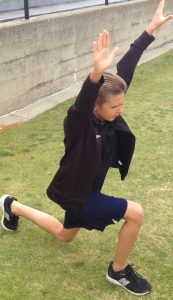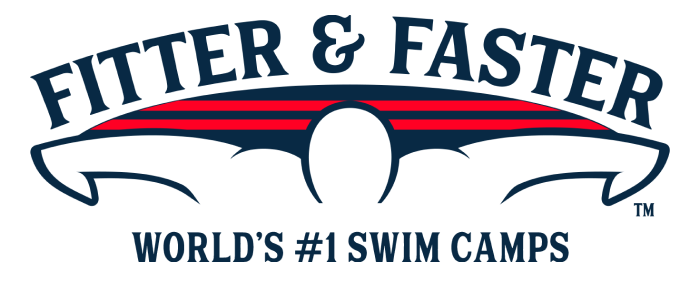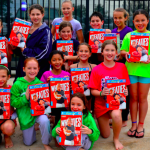About the Author: Nick Folker is the Founder of Folker Aquatic Strength Camp; Speed Training (F.A.S.S.T). Located in Berkeley, CA, Folker has been the strength coach for several NCAA and the world’s top swimmers. An Olympian who represented South Africa at the 2000 Olympics in Sydney, Folker has been an innovator in “dryland” training to build stronger, injury-free athletes.
The vast number of swimmers that the Fitter and Faster Swim Tour is reaching and the amazing experience that the clinics provide, aligns with the mission statement at TrainFASST – to create a positive, lasting impact in swimming through dryland training, for grassroots to elite-level swimmers.
Why is Dryland so Important for Swimmers?
Dryland training is everything you do outside of the water. It is a way for swimmers to improve their swimming performance and even prevent injuries. It should create a base to prolong a swimmer’s career, preparing young and adolescent swimmers for their potential collegiate careers and beyond.
It goes without saying that I am an advocate of dryland training for young swimmers. I was fortunate to grow up in South Africa at a time when we had to take part in a different sport each quarter at school. We were not specializing in a particular sport at a young age. We were moving freely and learning new movement patterns and skills from early on without even knowing it. More importantly, we were having fun!

A successful training system, of which dryland is one of the key components, will prepare a swimmer physically, psychologically and technically. The dryland training program must complement (1) each swimming practice; (2) phase of the season; and (3) progression of the athlete in his or her career.
Dryland should be a piece of the puzzle that aids in swimming faster, not just a piece in the puzzle to fill up a 30 or 60 minute time-slot of training.
The Focus of Dryland Training
A strong dryland program focuses on two principles: (1) “long-term athlete development” and (2) the teaching of fundamental athletic movements to athletes through a progression of exercises. The importance of “progression” cannot be stressed enough.
When an athlete learns a simple exercise such as a “squat” using only his body weight, this does not mean he is ready to jump into a set of squats with a barbell on his back. Each movement must progress through a series of fundamental movement patterns, which enables an athlete to gain strength and increase resistance or weight as he or she grows older. In the example of the athlete learning a squat, the next exercise in the progression would be a series of squats while holding a light-weight medicine ball for resistance.
Most young swimmers practice enough yardage. The dryland should complement the swimming work and supplement deficiencies in the athlete or the workout. The starting point for each athlete is going to be different depending on age, gender, experience and physical fitness.
What Makes a Successful Dryland Program?
Swimmers need to be taught how to move proficiently outside of the water. Generally, the program for younger athletes will start with body-weight, corrective exercises that will prepare them for the multi-planar movements and coordination work that follows in their progression. Core work is often performed through exercises like lunges versus just crunches. While I do prescribe some exercises on the ground for base work, core work does not mean just lying on the ground doing crunches or v-ups.
I’m often asked at what age a swimmer should start a dryland program. There is no one correct age or time in their career. In my opinion, young swimmers can’t get enough of body weight exercises.
Until an athlete can control his/her own body weight and learn to move it efficiently through multiple planes, he/she has no business doing weight training at ANY age.

Young swimmers need to be taught how to move proficiently, which in turn translates into improved overall athleticism, coordination, motor control and ultimately better swimmers.
Dryland programs should be designed to fit the needs and level of the particular swimmer or training group. Below is a high level overview of a dryland program structured with the proper progression and designed to teach the fundamentals of stability, athleticism and injury-prevention to swimmers.
Establishing Kinetic Awareness at a Young Age
Swimmers in the 7 to 10 year-old category should be encouraged to play games in a confined space. This increases spatial awareness, proprioception and accelerates motor control as they are thinking and reacting on the move.
Sample workout:
- Any games that cause the athlete to focus on moving, thinking and reacting at the same time
- Shorten the field of play to force the athletes to become hyper aware of their surroundings
- Creative game examples: Tag in a smaller area, soccer on a ¼ length sized field, Six Square with a ball (same rules as Four Square, but with Six Squares)

 Introducing Structured Movements
Introducing Structured Movements
Games for swimmers in the 10 to 12 age group (yes, there is some overlap at 10 years old) should decrease, and learned movement patterns should be introduced. Swimmers should be taught the correct form in performing a lunge, a wall sit, a front bridge, etc. Stability, especially through a range of motion, is crucial in this developmental phase. As a side note – do not cut out all games from the earlier age group. Just decrease the number of days per week or per phase that the swimmers play. Keep them having fun at this age.
Sample Exercises:
- Dynamic Warm-up
- Band – Internal/External rotations
- Crawling
- Front bridge
- Bodyweight reverse lunges
- Low bodyweight step-ups
- Bodyweight wall sits
- Band scapula retractions
- Seated band rows

Laying the Foundation for Complex Movements
The 13 to 14 age range is where the attrition rate in swimming begins. Many swimmers get scared away from swimming because they are told to specialize in a single sport, and those who stay in swimming are told to specialize in an event or training group. Encourage swimmers who have a variety of interests to play multiple sports or take part in multiple cultural activities such as theater, dance or music.
In the 13 to 14 age range, a lot of external factors come to the forefront that will affect a swimmer’s performance. This age group is the feeder group into the Senior or Senior Elite training group, so give them the attention and preparation that they deserve. This is an age range that requires one of the best coaches on any coaching staff. More than any other age group, you are preparing the stars of tomorrow, so build a solid foundation while encouraging them to stay in the sport.
In my own journey as a swimmer, I was a “late bloomer.” As a child, I developed severe asthma and was advised to swim in order to play the other sports that I loved, such as cricket and rugby. The buoyancy of the water took a lot of pressure off my chest and heart. I never swam year-round as was playing other sports in addition to swimming to help with my asthma.
I later realized that the crossover from the land sports to swimming and vice versa kept me fresh and enjoying each sport. My conditioning improved from the different training methods, external stimuli and different energy systems being trained. My point in this story, is not “box” or classify your swimmers without giving them the tools and conditions to allow them to thrive and create their own journey to success. Dryland is a part of this toolbox.
Sample Exercises:
- Dynamic Warmup
- Crawling with bands
- Inchworms
- Lunges – introduce front, lateral and rotational lunges
- Vary the type of pushups. Girls should be moving off their knees from the 11-12 age group progression.
- Introduce low-level plyometrics if the swimmers are stable and their joints can handle it.
- Stability ball wall squats – add light dumbbells to this progression
- Suspension training is introduced – TRX, Jungle Gym – other bands/straps.
- Rows, squats, lunges, etc.
- Stability ball work is introduced.

Progression to the Senior Level
By ages 15 or 16, all swimmers should be able to lunge in multiple directions and not look like a new-born giraffe. Introduce light medball, dumbbell and kettlebell loading if body weight progressions have been met. All girls should be able to perform a number of repetitive kneeling pushups without their lower-backs caving in and boys likewise with regular pushups. Both male and female swimmers should be able to pass the “pull test,” which means that they have mastered scapula retraction and have sufficiently strengthened their thoracic spine region.
Sample Exercises:
- Dynamic Warmup
- Swimmers’ exercise library should be extensive by now if started in the 7 to 10 or 10 to 12 age groups.
- Most lower-extremity movements should require external resistance (medballs, dumbbells, kettlebells)
- Male and female swimmers should be ready to progress into vertical pull exercises
- Plyometric exercises are increased through phases.
Dryland for Pre-College Level and “Late Bloomers”
If you have gone through a well-calculated progression as a younger athlete, you should be performing free of injury or close to it. You should be well versed in the basic movements you will experience as you move on to your collegiate career.
Sample Exercises:
- Dynamic Warmup
- Introduce the barbell if available to prepare swimmers for collegiate careers. Obviously, there will be special cases where certain athletes will progress faster than others and be able to handle a barbell in certain exercises in the 15 to 16 year-old age range.
- There is no hard and fast rule with exercises in this age range; however, depending on their specific strokes and race demands, all swimmers in this range should have progressed to a point where they can handle a barbell, dumbbells, medballs, kettlebells, stability balls and suspension training.
Focus on Long-Term Development
As a swimmer progresses and passes more levels in the assessment process, more complex exercises and movement patterns are prescribed. They need to pass through a number of progressive body weight phases, which also include resistive band work before external resistance such as medballs, light dumbbells and kettlebells are introduced. Introducing these movements as part of a progression ensures that an athlete is learning the proper technique and building a stable dryland foundation, which will help prevent injuries in the water. Only when these loads and progressions have been mastered and their joints can handle the load is the barbell brought in to the picture.
The frequency of dryland workouts depends on the swimmer’s events and dryland experience. In general, young athletes can do some form of dryland three to five times per week before they swim. If you’ve ever watched kids play outside or on the jungle gyms, they can go on forever. Therefore, I believe they can handle doing some form of movement in an instructional setting up to five times per week.
Regardless of the age, the focus should always be on the quality of the movement being performed. The movements a 7 to 10 year-old learns will eventually translate into body weight exercises when they are 13 to 14. The body weight exercises learned at this stage will ultimately become weighted or include resistance exercises that prepare the athlete for college. Not only does this keep the athlete engaged in what they are learning, but it will challenge them and make dryland a fun part of their training.
Tying it all Together
In summary, the key components of a successful dryland program include:
- Train movement patterns, not individual muscle groups
- Progression, progression, progression!
- Challenge the swimmers, within the progression.
- Be passionate about the dryland training.
- Don’t just do it to do it – research it, understand it, make it synergistic to your swimming program.
- Be careful of pulling exercises off the internet. You don’t know what progression led to the exercise or how it fits into that particular program or the athlete’s progression.
- Make swimming and dryland training FUN!
Good luck and swim FASST!
Ways to reach Nick:
Facebook/TrainFASST.com
trainfasst.com








